Short-duration physical activity prevents the development of activity-induced hyperalgesia through opioid and serotoninergic mechanisms
- PMID: 28621702
- PMCID: PMC5561491
- DOI: 10.1097/j.pain.0000000000000967
Short-duration physical activity prevents the development of activity-induced hyperalgesia through opioid and serotoninergic mechanisms
Abstract
Regular physical activity prevents the development of chronic muscle pain through the modulation of central mechanisms that involve rostral ventromedial medulla (RVM). We tested if pharmacological blockade or genetic deletion of mu-opioid receptors in physically active mice modulates excitatory and inhibitory systems in the RVM in an activity-induced hyperalgesia model. We examined response frequency to mechanical stimulation of the paw, muscle withdrawal thresholds, and expression of phosphorylation of the NR1 subunit of the N-methyl-D-aspartate receptor (p-NR1) and serotonin transporter (SERT) in the RVM. Mice that had performed 5 days of voluntary wheel running prior to the induction of the model were compared with sedentary mice. Sedentary mice showed significant increases in mechanical paw withdrawal frequency and a reduction in muscle withdrawal threshold; wheel running prevented the increase in paw withdrawal frequency. Naloxone-treated and MOR mice had increases in withdrawal frequency that were significantly greater than that in physically active control mice and similar to sedentary mice. Immunohistochemistry in the RVM showed increases in p-NR1 and SERT expression in sedentary mice 24 hours after the induction of the model. Wheel running prevented the increase in SERT, but not p-NR1. Physically active, naloxone-treated, and MOR mice showed significant increases in SERT immunoreactivity when compared with wild-type physically active control mice. Blockade of SERT in the RVM in sedentary mice reversed the activity-induced hyperalgesia of the paw and muscle. These results suggest that analgesia induced by 5 days of wheel running is mediated by mu-opioid receptors through the modulation of SERT, but not p-NR1, in RVM.
Conflict of interest statement
The authors declare no conflict of interest.
Figures

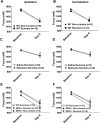
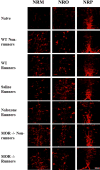
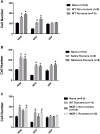
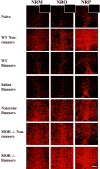
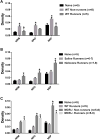
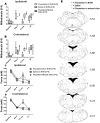
Similar articles
-
Regular physical activity prevents development of chronic muscle pain through modulation of supraspinal opioid and serotonergic mechanisms.Pain Rep. 2017 Aug 21;2(5):e618. doi: 10.1097/PR9.0000000000000618. eCollection 2017 Sep. Pain Rep. 2017. PMID: 29392233 Free PMC article.
-
Regular physical activity prevents development of chronic pain and activation of central neurons.J Appl Physiol (1985). 2013 Mar 15;114(6):725-33. doi: 10.1152/japplphysiol.01317.2012. Epub 2012 Dec 27. J Appl Physiol (1985). 2013. PMID: 23271699 Free PMC article.
-
Changes in expression of NMDA-NR1 receptor subunits in the rostral ventromedial medulla modulate pain behaviors.Pain. 2010 Oct;151(1):155-161. doi: 10.1016/j.pain.2010.06.037. Epub 2010 Aug 4. Pain. 2010. PMID: 20688433 Free PMC article.
-
Female specific interactions of serotonin and testosterone in the rostral ventromedial medulla after activity-induced muscle pain.J Pain. 2025 Jan;26:104723. doi: 10.1016/j.jpain.2024.104723. Epub 2024 Nov 8. J Pain. 2025. PMID: 39522853
-
Descending facilitation from rostral ventromedial medulla mu opioid receptor-expressing neurons is necessary for maintenance of sensory and affective dimensions of chronic neuropathic pain.Pain. 2025 Jan 1;166(1):153-159. doi: 10.1097/j.pain.0000000000003360. Epub 2024 Jul 26. Pain. 2025. PMID: 39058958
Cited by
-
Regular physical activity reduces the percentage of spinally projecting neurons that express mu-opioid receptors from the rostral ventromedial medulla in mice.Pain Rep. 2020 Dec 2;5(6):e857. doi: 10.1097/PR9.0000000000000857. eCollection 2020 Nov-Dec. Pain Rep. 2020. PMID: 33294758 Free PMC article.
-
Regular physical activity prevents development of chronic muscle pain through modulation of supraspinal opioid and serotonergic mechanisms.Pain Rep. 2017 Aug 21;2(5):e618. doi: 10.1097/PR9.0000000000000618. eCollection 2017 Sep. Pain Rep. 2017. PMID: 29392233 Free PMC article.
-
G protein-coupled estrogen receptor in the rostral ventromedial medulla contributes to the chronification of postoperative pain.CNS Neurosci Ther. 2021 Nov;27(11):1313-1326. doi: 10.1111/cns.13704. Epub 2021 Jul 13. CNS Neurosci Ther. 2021. PMID: 34255932 Free PMC article.
-
Exercise-induced pain and analgesia? Underlying mechanisms and clinical translation.Pain. 2018 Sep;159 Suppl 1(Suppl 1):S91-S97. doi: 10.1097/j.pain.0000000000001235. Pain. 2018. PMID: 30113953 Free PMC article. Review.
-
Intrinsic Activity of C57BL/6 Substrains Associates with High-Fat Diet-Induced Mechanical Sensitivity in Mice.J Pain. 2018 Nov;19(11):1285-1295. doi: 10.1016/j.jpain.2018.05.005. Epub 2018 May 25. J Pain. 2018. PMID: 29803670 Free PMC article.
References
-
- Arvidsson U, Cullheim S, Ulfhake B, Ramírez V, Dagerlind Å, Luppi PH, Kitahama K, Jouvet M, Terenius L, Åman K. Distribution of enkephalin and its relation to serotonin in cat and monkey spinal cord and brain stem. Synapse. 1992;11(2):85–104. - PubMed
-
- Basbaum AI, Fields HL. Endogenous pain control systems: brainstem spinal pathways and endorphin circuitry. Annu Rev Neurosci. 1984;7(1):309–338. - PubMed
-
- Bement MKH, Sluka KA. Low-intensity exercise reverses chronic muscle pain in the rat in a naloxone-dependent manner. Arch Phys Med Rehabil. 2005;86(9):1736–1740. - PubMed
-
- Bidonde J, Jean Busch A, Bath B, Milosavljevic S. Exercise for adults with fibromyalgia: an umbrella systematic review with synthesis of best evidence. Current rheumatology reviews. 2014;10(1):45–79. - PubMed
MeSH terms
Substances
Grants and funding
LinkOut - more resources
Full Text Sources
Other Literature Sources
Research Materials

